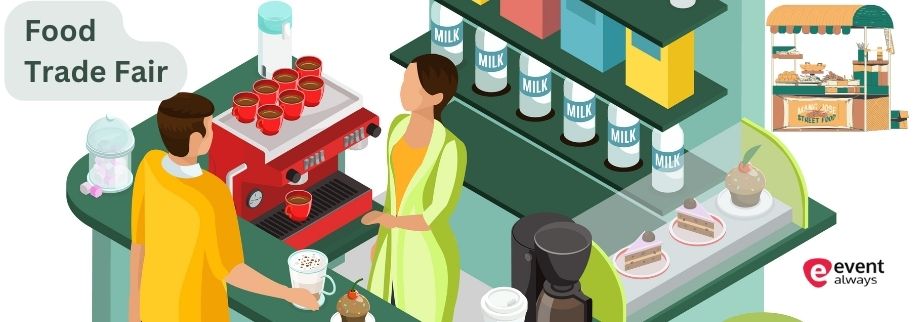In the dynamic and competitive world of the food industry, participating in trade fairs is not just a business opportunity; it’s a necessity. These events provide a webinar platform for food businesses to showcase their products, network with potential clients, and stay updated on the latest industry trends. However, standing out in the crowd and making the most of these trade fairs can be a daunting task. That’s where we come in. In this comprehensive guide, we will unveil the strategies and insights you need to expand your food trade fair business.
What is the Food Trade Fair?
A food trade fair, also known as a food trade show or food exhibition, is an event or exhibition where businesses in the food industry gather to showcase their products, services, and innovations to a targeted audience. These events provide a platform for food producers, manufacturers, distributors, and related businesses to:
Display Products: Food trade fairs allow companies to showcase their food products, whether they are new product launches or established offerings.
Network and Connect: Attendees have the opportunity to network and establish valuable connections within the industry.
Market Research: Food trade fairs are an excellent opportunity to conduct market research.
B2B Transactions: Many food trade fairs facilitate business-to-business (B2B) transactions. Buyers can negotiate deals with suppliers, and distributors can explore new product lines to add to their portfolios.
The Power of Preparation
Setting Clear Goals
Before you step foot onto the trade show industry, it’s imperative to set clear, achievable goals. Are you looking to generate leads, launch a new product, or strengthen existing partnerships? Having well-defined objectives will guide your entire trade fair strategy.
Booth Design and Presentation
Your booth is your storefront at a trade fair, and first impressions matter. Consider interactive elements, such as product tastings, live cooking demonstrations, or engaging displays, to draw visitors in.
Leveraging Technology
Embracing Social Media
In today’s digital age, leveraging social media is non-negotiable. Create a buzz before the event by posting teasers, countdowns, and behind-the-scenes glimpses of your preparation. During the trade fair, keep your audience engaged with live updates, photos, and videos. Utilize event-specific hashtags to maximize your reach.
Mobile Apps and Networking Tools
Many trade fairs now have dedicated mobile apps that facilitate networking. Download these apps in advance and use them to connect with other exhibitors and attendees. You can schedule meetings, exchange contact information, and even arrange on-the-spot collaborations.
Networking and Relationship Building
Quality Over Quantity
When it comes to networking, remember that it’s not about how many business cards you collect but the quality of connections you make. Engage in meaningful conversations, listen actively, and show genuine interest in others’ businesses. Building strong relationships can lead to long-term partnerships.
Host Private Events
Consider hosting exclusive events or parties for select attendees and potential clients. These gatherings provide a more intimate setting for networking and can leave a lasting impression on your guests.
Maximizing Your Exposure
Sponsorship Opportunities
Explore event sponsorship opportunities within the trade fair. Sponsorship often comes with benefits like prominent booth placement, logo placement in event materials, and speaking opportunities.
Speaking Engagements
Speaking at trade fair seminars or workshops can position you as an industry expert. Share valuable insights, case studies, and trends. Attendees are more likely to visit your booth after seeing you on stage.
Post-Event Follow-Up
Timely Follow-Ups
Once the trade fair concludes, the real work begins. Timely follow-ups are crucial. Reach out to the contacts you made, thanking them for their time and expressing your interest in potential collaborations. Personalized follow-up emails or calls can make all the difference.
Conclusion
Expanding your food trade fair business is a multifaceted endeavor that requires careful planning, innovation, and dedication. By setting clear goals, leveraging technology, nurturing relationships, and maximizing your exposure, you can make each trade fair a resounding success. Remember, success at trade fairs is not just about making sales; it’s about building lasting connections that will propel your business forward.

